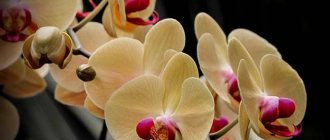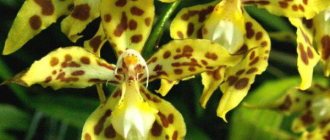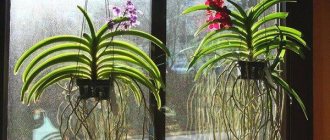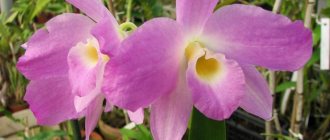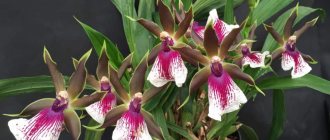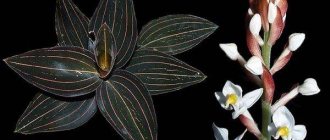In the large family of Phalaenopsis, you can sometimes notice plants with an unusual bud shape. As a result of the mutation, the flower grows together, and outwardly it looks like an unopened bud. The two horizontal petals transform into a lip, and the flower becomes asymmetrical. This phenomenon is not considered permanent; pelorica orchids may produce regular flowers in the future. This article talks about the varieties of phalaenopsis pelorica, their distinctive features, as well as the rules for planting, propagating and caring for flowers.
Distinctive features
There are unstable forms of mutation; one plant can produce a peloric and a regular flower. The appearance of peloricity is associated with genes, but sometimes on an ordinary flower it occurs as a result of poor care or stress. In such plants, peloricity is unstable; when comfortable conditions are restored, the mutation may disappear and the plant will bloom as usual.
What is the difference between the peloric orchid and other flowers in this family? In addition to the unopened bud, sometimes various petals or sepals grow, resembling a lip in shape and color. You can look at the photo of the peloric orchid and appreciate the unusual appearance of the flower.
This plant has a peculiar appearance. In addition, sometimes the petals become thicker. All biologists are unanimous in the opinion that this is a mutation of the plant, and amateur flower growers sometimes strive to purchase peloric flowers. Further in the article - about the most famous varieties of the Phalaenopsis peloric orchid.
External characteristics
To understand how butterfly orchids differ from other varieties, it is enough to consider their external characteristics.
Mature plant height
There are 4 standards of orchids, the size of which differs significantly:
- Mini – maximum height 20 cm.
- Midi - an adult plant reaches a height of 50-55 cm.
- Regular - able to grow up to 65-75 cm.
- Royal is the tallest variety, reaching 80 cm.
It is recommended to choose pots according to the size of the plant.
Number of leaves
If phalaenopsis does not exhibit pathologies or diseases, then on each shoot you can see from 4 to 6 leaf blades. The leaves are quite fleshy, shiny, and have a rich dark green hue. The growth is carried out alternately, with the upper leaves being much larger in size than the lower ones.
Maximum peduncle length
As practice shows, the length of the peduncle is identical to the height of the plant. The maximum size can reach 100 cm.
Flower shape diameter
The butterfly orchid, a photo of which can be seen below, forms flower stalks, a state of 3 petals. The buds resemble butterflies in appearance and shape. The side petals are the largest, the third is located in the center.
Preparing the soil for planting
Like all orchids, pelorics need well-chosen soil. It is the basis for the proper development of a flower. A substrate is prepared for the plant from pine bark (you can take it from other coniferous trees), sphagnum moss and a small amount of inert materials: vermiculite, expanded clay, perlite. These materials serve as drainage and promote better aeration of the roots.
When using expanded clay for planting, it is necessary to take into account that the roots of the orchid easily grow into it, this leads to some difficulties in further transplanting the flower. In this case, the roots must be carefully separated from the expanded clay.
The basis of the substrate is bark. Before planting, it must be dry and free of pests. You can pre-steam it in the oven. The bark absorbs all salts from the water well and acts as a filter.
If there is no desire or opportunity to prepare the substrate yourself, it can be purchased at flower shops. The quality of the finished material does not cause any complaints among experienced gardeners involved in breeding orchids.
Selection of container and planting
All orchids absorb light through their roots, so you need to choose transparent pots for them. Their sizes must be selected according to the volume of the root system.
Planting orchids is usually not difficult. A drainage layer is laid on the bottom of the pot, then the plant with a lump of earth is carefully placed and covered with substrate. The root collar should not reach three centimeters to the edge of the pot.
The planted plant is removed for two weeks in a moderately cool room for adaptation. Then the orchid is determined to a permanent place.
Watering and fertilizing
It is when growing the phalaenopsis pelorica orchid that watering is of great importance. Most varieties of this plant love moisture, but here you should not be too zealous and flood the flower. You need to focus on the drying of the soil and the color of the roots.
With normal humidity in the apartment, the soil usually dries out on the 3-4th day. The roots take on a silver-gray tint. This means that the flower already needs watering. The dry climate in the apartment negatively affects the leaves of the peloric orchid. In this case, it is necessary to spray the leaves of the flower, but make sure that water does not get on the buds.
It is recommended to fertilize once a month; in winter it is reduced to once. They use special complex fertilizers, which can be purchased at flower shops.
Growing conditions
To grow a strong, healthy flower, it is important to observe a number of conditions.
Optimal temperature:
- during the day—from 20 to 25°C;
- at night - from 15 to 18°C.
When it rises to +35°C and above or drops below +12°C, there is a high risk of flower death.
Experts advise providing phalaenopsis with a difference between day and night temperatures of 5-6°C, this will promote more active flowering.
Humidity
The culture loves well-humidified air. The most comfortable humidity is from 50 to 80%. It tolerates significant fluctuations, but when the indicator decreases to 30% or less, it begins to shed buds and flowers, and when it increases above 80%, the risk of fungal diseases increases.
If the level is insufficient, you must:
- buy expanded clay, gravel, fill a wide tray with them, moisten them;
- Place the pot with the plant on top so that the bottom does not come into contact with water.
It is advisable to irrigate the leaves periodically with warm, settled water.
Lighting
Although phalaenopsis likes well-lit places, it is not advisable to place them in direct sunlight. The most favorable daylight hours are from 10 to 12 hours.
With a lack of light, especially in autumn and winter, the plant begins to shed flowers and buds.
A way out of the situation may be additional illumination with phytolamps, which do not make the air dry and do not overheat it.
The best place in an apartment for growing orchids are windows facing east or west. In the south, they need to be shaded.
Replanting a plant after purchasing it in a store
An orchid purchased in a store must be transplanted from a temporary container into a permanent pot. In this case, the entire temporary substrate is completely replaced, leaving only an earthen lump on the roots. An actively flowering plant does not need to be replanted immediately, as this will cause the buds to fall off.
A plant without flowers is transplanted into a permanent pot. Phalaenopsis peloric orchid tolerates transplantation well. The main thing is to choose a high-quality substrate for it. The flower is carefully removed from the temporary pot and the roots are carefully examined. If there are rotten areas, they must be removed. The cut areas are treated with crushed activated carbon.
Then carefully lower the orchid’s root system into a new pot, carefully straightening the roots so that they do not bend. Pour wet substrate into the pot and place the plant for acclimatization. Watering is stopped for two weeks, and the flower pot is placed in a cool, shaded place.
Reproduction methods
- Vegetative. If an adult phalaenopsis is well developed, you can cut off its top and plant it in a loose substrate for rooting. The baby can also appear from a dormant bud at the base of the peduncle. They wait for its roots to grow about 5 cm, then separate it and plant it in a transparent container. The same is done with the lateral processes.
- Growing from seeds. It is best to use seeds from a green pod, taken about a month before its normal opening, that is, 4-4.5 months after pollination. They quickly lose their viability; they can be briefly extended by storing them in the refrigerator. The sown seedlings will be ready for transplanting from flasks into common pots in about six months. After transplantation, they are covered with glass to achieve a greenhouse effect. When the seedlings have grown sufficiently and become strong, they are transplanted into pots with a diameter of 10 cm.
At home, vegetative propagation is usually used due to the complexity of the procedure for growing from seeds.
Stimulating flowering
Typically, Phalaenopsis peloric hybrids bloom twice a year. Some gardeners are faced with the problem that the plant does not bloom, despite all their efforts. This is mainly due to the fact that it does not have enough light.
If the orchid does not bloom, this problem can be solved in two ways. Some gardeners provide the plant with additional artificial lighting.
Another way is to put the flower in a cool room where the temperature does not exceed 16 °C, and also reduce watering. The flower is kept in such conditions for 20 to 30 days, and then returned to normal conditions. After this, the orchid forms arrows and blooms. After the plant has finished flowering, the peduncle is cut off, but if it does not dry out, it can be left on the plant, since it will produce buds again in the future.
Main features of flowering
Flowering occurs when the plant reaches the age of 2.5-3 years. The beginning of the process is quite problematic to recognize, since at the same moment adventitious roots begin to appear. Peduncles are recognized by their pointed tip and the presence of scales.
Prevention of diseases and pests
Infectious diseases rarely affect Phalaenopsis pelorica. They usually suffer from improper care. Direct sunlight can cause leaf scorch if the plant is placed on a windowsill on the south side of the house.
Orchids often suffer from excessive watering, the roots of the plant rot, and the green part dries out. Lack of lighting and keeping them in a cold room can also cause disease and death of the plant. A dense arrangement of orchids is not recommended; free air circulation is necessary for each plant. Periodically you need to ventilate the room, avoid allowing moisture to get on the buds when spraying. Irrigation of leaves is carried out in the first half of the day.
Sometimes pests are found on a plant sold in a store. In this case, the root system is completely separated from the soil in which the flower was sold. The plant is placed under water at room temperature and the roots are thoroughly washed.
Pelorics require high humidity in the room, but this can be easily achieved by placing a tray filled with damp pebbles or expanded clay next to the orchid. Creating comfortable conditions for keeping an orchid will protect the plant from various diseases.
Popular varieties
Of the huge number of varieties, we list the names of the most famous and original ones.
Black butterfly. A very beautiful and unusual phalaenopsis, the color of which, depending on the lighting, varies from rich dark burgundy with a chocolate tint to almost black.
The color 100% black does not exist due to the lack of the corresponding pigment genes.
The petals have a pointed shape, the one located in the core (lip) is white-yellow, with a burgundy edge. There are up to 8 flowers on the peduncle, reaching 5 cm.
Diamond King. It has bright burgundy flowers with a light border (diameter - 8 cm). The petalia closer to the center is white, with small leopard print patches, similar to freckles.
Manhattan. Currently, this hybrid is not registered, it only has a trade name. The flowers are soft pink or soft lilac, strewn with many small dotted burgundy inclusions, reminiscent of a marble pattern, with a bright orange or yellow center.
The peculiarity of the variety is that the inclusions may disappear if there is insufficient light.
Pavarotti. The variety is known for its dense, almost monochromatic flowers of a rich wine shade. The diameter of the flowers is up to 8 cm.
Valencia. A rather rare variety of large phalaenopsis, growing up to 60 cm in height (including peduncle). The sepals and petals are snow-white, the lip is large, yellow inside and white outside. The center is deep burgundy, with an orange rim. Flowering period - up to 8 months.
Kimono. The color of the flowers is mottled purple, with a whitish-yellow border. The veins and tongue are darker, burgundy, the center is yellow-raspberry. They reach 7 cm in diameter.
Phalaenopsis has a huge variety of varieties
Legato. A hybrid with an unusual range of colors: on 2 peduncles reaching a height of up to 60 cm, flowers of soft pink, peach, golden-lilac pearl color appear twice a year and bloom for more than 8 weeks. Closer to the center, the silky petals have dark specks. The core is bright orange.
The peculiarity of the hybrid is the fear of drafts and direct sunlight; it can die at temperatures above +35°C.
Separately, it is worth considering peloric orchids.
Pelorik is not a variety of orchid. This is the name given to plants that have non-standard bud shapes. Modification occurs as a result of mutation. Most often, petals grow together, as a result of which the bud does not open completely; sometimes different sepals or petals grow, taking the shape or shade of a lip.
A flower from monosymmetric (having 1 axis of symmetry) turns into radially symmetric, with several axes of symmetry.
Information: during hybridization, peloricity is permanent; ordinary flowers no longer appear on the plant.

